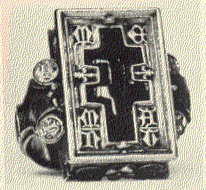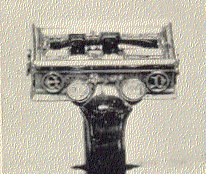
A ring found in the Thame Hoard
In April 1940 a local lorry driver called Willocks McKenzie discovered a 'hoard' of coins and rings on the banks of the river Thame, a short distance upstream of the Long Crendon Bridge.
Mud had been dredged from the river the previous summer, and so the hoard may have originally been lost, or deliberately hidden, in the river Thame itself.
It turned out that the hoard may have been in the river for four hundred years.
A distinctive cross with two horizontal sections found on one of the rings is now a part of the Thame Cross, the emblem or logo of Thame Town Council.
Willocks McKenzie informed the local police of what he had found, since the coins and rings appeared to be of great value. As is the practice in such cases, the Coroner was informed and an inquest was held.
As a result of an assessment given by the Ashmolean Museum in Oxford, the Coroner declared the hoard to be Treasure Trove, and therefore the property of the Crown.
Fortunately, the authorities consented to the hoard being given into the care of the Ashmolean Museum, Oxford, which is where it remains to this day.
There were ten coins and five rings contained in the hoard.
All the coins were groats. The later coins show little sign of having been in circulation. The youngest dates from around the year 1457, which would have been taken as the date of the hoard itself, were it not for the rings, one of which is of a later date.
The coins in detail are :-
- a coin of Edward III, from the London mint, dating to around 1351.
- a coin of Richard II (1377-1399), from the London mint.
- a coin of Henry V (1413-1422), from the London mint.
- 3 coins of Henry VI, from the Calais mint and dating to around 1422-25.
- 3 coins of Henry VI, from the Calais mint and dating from around 1428-33.
- a coin of Henry VI, from the London mint and dating from around 1457.
It is the rings, however, that mark the Thame Hoard out as a find of such importance.
The first ring is of a fourteenth century type, with a turquoise stone. Stones of different types were generally believed in those times to have magical qualities, as some believe today. This is the original purpose of placing stones in rings, where they would be close to the skin.
The second ring is much larger, with a large 'toad-stone', which was said to bring victory over a man's enemies. This ring is of fifteenth century origin.
The third ring has no stone, and is a gold hoop with the words 'tout pour vous' in black letters. It dates from the early fifteenth century.
These three rings are thought to be secular, that is not worn by men of the Church. The fourth ring however bears a very strong resemblance to one worn by William Wytlesey, Bishop of Rochester and Worcester, who became Archbishop of Canterbury in 1368. It too has a stone thought to bestow good fortune on the wearer, a peridot.
The fifth and final ring is by far the most splendid, and the most obviously ecclesiastical. It is surmounted by a one inch long ornate box, with an intricate opening mechanism, which served as a reliquary, in which a religious relic could be placed.
The lid of the box is decorated with a cross with a double traverse, that is, two cross members. This cross is cut from a single piece of amethyst. The underside of the box carries a representation of the Crucifixion, with the Virgin Mary and St. John the Baptist standing below, and the sun and moon above.
Around the cross and also the ring itself, letters spell out 'Memanto Mei Dominie', or 'Remember Me Lord'.

The ring from the side
The decoration around the ring, including the use of fleur-de-lys emblems to fill spaces, is thought to place this fabulous jewel in the early part of the sixteenth century.
The double traverse cross found on this ring has been used within the Thame Town Council emblem, which borrows the shape of the Thame Hoard cross and surrounds it with other symbolic images of Thame, such as a wheatsheaf and wool shears.
Double traverse crosses, and indeed cross-reliquaries with them, show a Byzantine influence, and became popular in the centuries following the Crusades. The double traverse cross also became an emblem of the House of Anjou, and was later adopted by the Dukes of Lorraine.
As to the circumstances in which the Thame Hoard became lost, or was hidden, and the identity of the person or persons who last owned them, then all we have is speculation.
The information on the Thame Hoard contained here is taken from a report published in the Antiquaries Journal in 1941, written by Joan Evans, E T Leeds and Anthony Thompson.
The conclusion reached in the report is that the hoard probably belonged to Robert King, the last Cistercian Abbot of Thame. The suggestion is that the jewels were hidden to prevent them being taken by the Crown at the Reformation.
More pictures of the Thame Hoard
The McKenzie family tells the story
The Thame Town Emblem
RobertKing